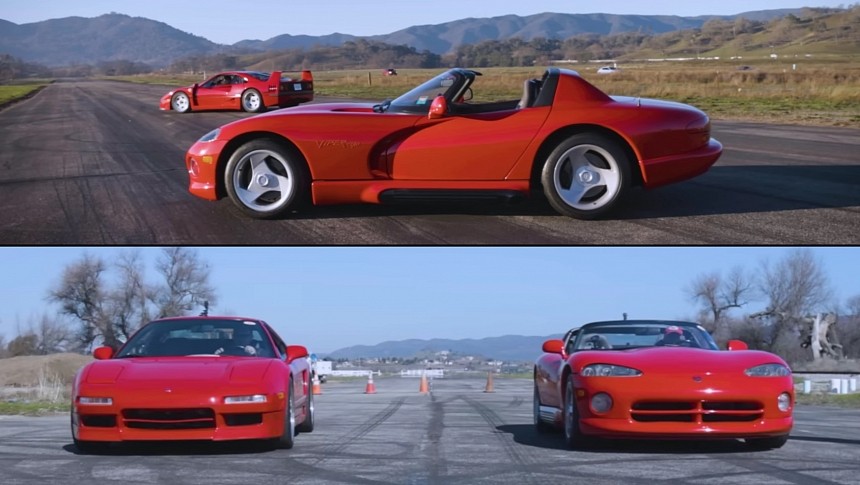The original Viper is more than simply bedroom poster material. It's rightfully considered an indirect successor to the Shelby Cobra, although the one and only Carroll Shelby did roll out a replacement of sorts in the form of the Shelby Series 1. Pictured at Santa Margarita Ranch in California, the V10-powered brute in the video below is tasked with racing a classic Ferrari that launched four years before the SR I-gen Viper.
Produced between 1987 and 1992, the F40 was expected to sell in the ballpark of 400 units. The Prancing Horse of Maranello eventually finished a little over 1,300 examples of the breed. An estimated 213 were destined for the US market. Whichever proves quicker in the quarter mile will then race a first-gen Acura NSX, which may be a bit underpowered for this task.
First things first, the Viper sings the song of its people by means of a naturally-aspirated V10 with Lamborghini know-how. As a brief refresher, Chrysler owned the Raging Bull of Sant'Agata Bolognese from 1987 to 1994. Related to the 8.0-liter Magnum V10 truck engine, the Viper-specific powerplant generates 400 horsepower at 4,600 revolutions per minute and 465 pound-feet (630 Nm) at 3,600 revolutions per minute.
The Fezza is rocking a twin-turbocharged V8 with 477 ponies on deck, plus 424 pound-feet (575 Nm) at 4,500 rpm. European models, by comparison, pump out 471 horsepower and 426 pound-feet (578 Nm) at 4,000 rpm. The F40's biggest drawbacks against the Viper – at least in this context – are the more fragile clutch and five gears versus the Viper's six.
Finally, the original NSX was offered with either 3.0- or 3.2-liter V6 engines. Neither mill can match the Viper's big-boy V10 or the Ferrari's twin-turbo'd V8. Honda developed the NSX specifically to handle rather than blitz the drag strip.
The NSX-T in this video is called this way after the roof's design. The targa became available in Japan and North America back in 1995, with the NSX-T replacing the coupe altogether in the United States. 1997 updates include a six-speed manual transmission, whereas earlier models came with either a five-speed manual or a four-speed automatic that arguably defeats the purpose of a great-handling sports car.
With these details out of our way, care to guess which car had its clutch abused the most at launch? That would be the Viper, which – believe it or not – won every single drag race against the F40 and NSX. The Dodge clocked a best of 13.3 seconds at 110 miles per hour (177 kilometers per hour), which is respectable even today, especially on an unprepped surface.
The NSX finished second in the pecking order, crossing the finish line in 14.4 seconds at 99 miles per hour (159 kilometers per hour). Last but not least, the F40 couldn't do better than 14.7 at 101 miles per hour (163 kilometers per hour), primarily because of the driver's unwillingness to destroy the clutch.
First things first, the Viper sings the song of its people by means of a naturally-aspirated V10 with Lamborghini know-how. As a brief refresher, Chrysler owned the Raging Bull of Sant'Agata Bolognese from 1987 to 1994. Related to the 8.0-liter Magnum V10 truck engine, the Viper-specific powerplant generates 400 horsepower at 4,600 revolutions per minute and 465 pound-feet (630 Nm) at 3,600 revolutions per minute.
The Fezza is rocking a twin-turbocharged V8 with 477 ponies on deck, plus 424 pound-feet (575 Nm) at 4,500 rpm. European models, by comparison, pump out 471 horsepower and 426 pound-feet (578 Nm) at 4,000 rpm. The F40's biggest drawbacks against the Viper – at least in this context – are the more fragile clutch and five gears versus the Viper's six.
Finally, the original NSX was offered with either 3.0- or 3.2-liter V6 engines. Neither mill can match the Viper's big-boy V10 or the Ferrari's twin-turbo'd V8. Honda developed the NSX specifically to handle rather than blitz the drag strip.
The NSX-T in this video is called this way after the roof's design. The targa became available in Japan and North America back in 1995, with the NSX-T replacing the coupe altogether in the United States. 1997 updates include a six-speed manual transmission, whereas earlier models came with either a five-speed manual or a four-speed automatic that arguably defeats the purpose of a great-handling sports car.
With these details out of our way, care to guess which car had its clutch abused the most at launch? That would be the Viper, which – believe it or not – won every single drag race against the F40 and NSX. The Dodge clocked a best of 13.3 seconds at 110 miles per hour (177 kilometers per hour), which is respectable even today, especially on an unprepped surface.
The NSX finished second in the pecking order, crossing the finish line in 14.4 seconds at 99 miles per hour (159 kilometers per hour). Last but not least, the F40 couldn't do better than 14.7 at 101 miles per hour (163 kilometers per hour), primarily because of the driver's unwillingness to destroy the clutch.




























